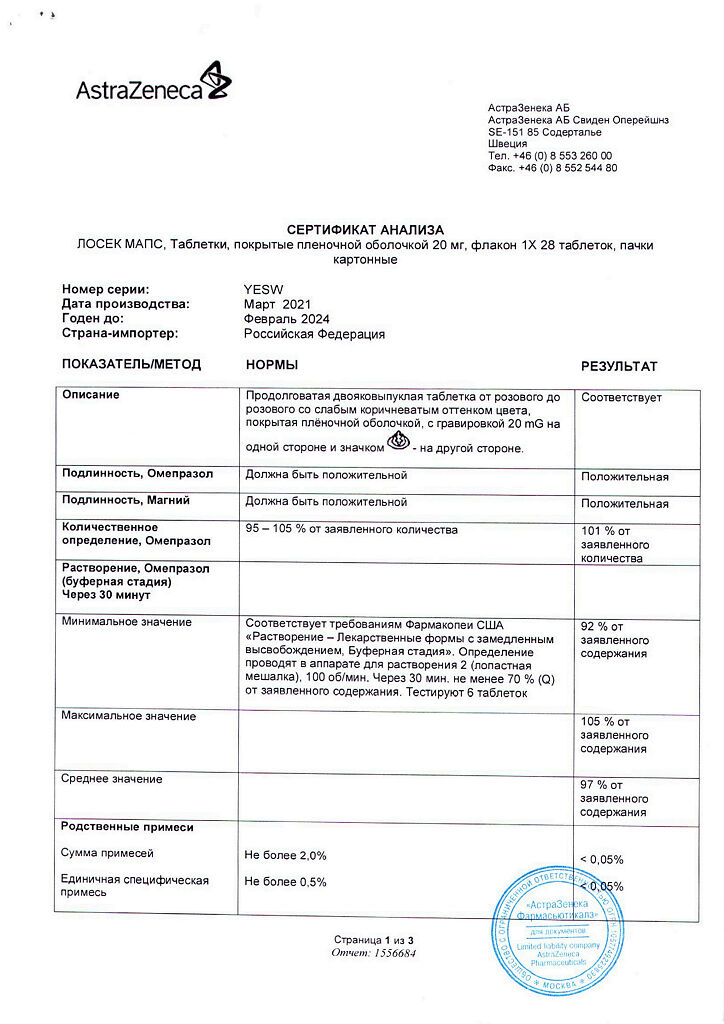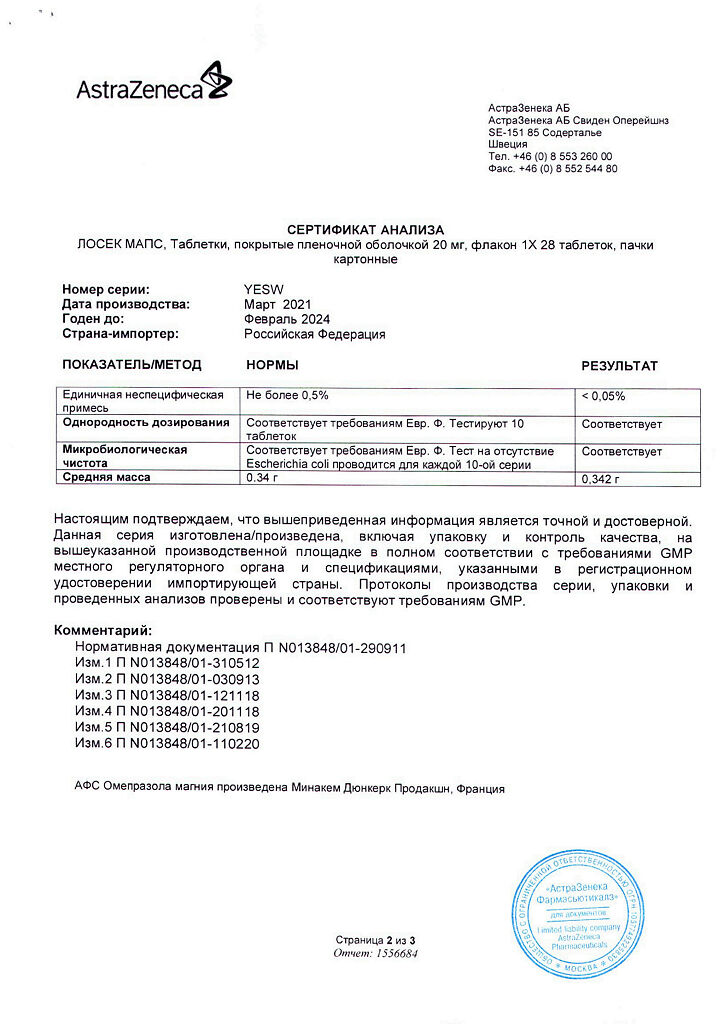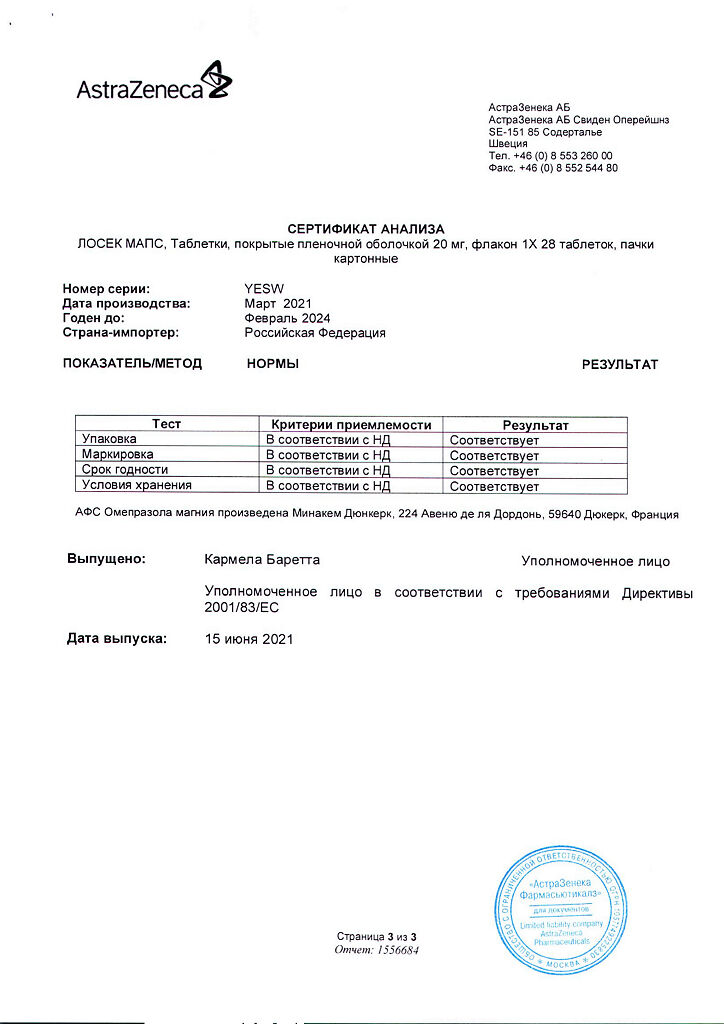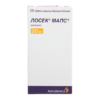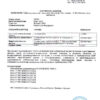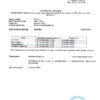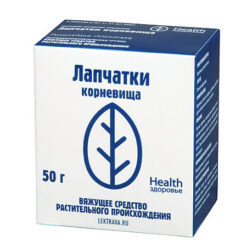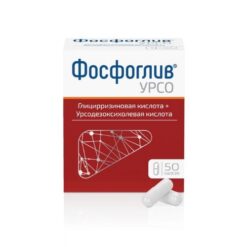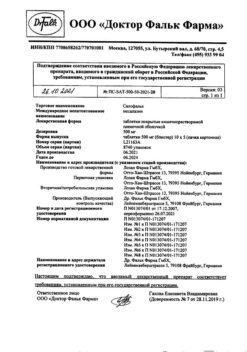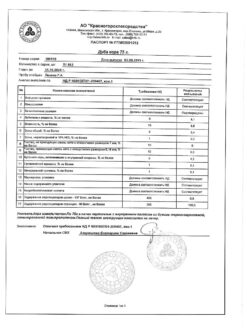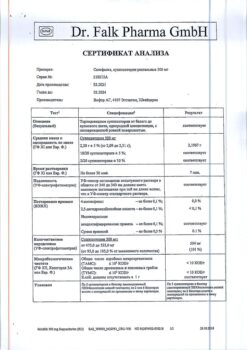No products in the cart.
Losek MAPS, 20 mg 28 pcs.
€12.93 €10.78
EAN: 4640008530442
SKU: 105047
Categories: Medicine, Stomach, intestines, liver, Ulcer and gastritis
Description
Mechanism of action
Omeprazole is a weak base. It is concentrated in the acidic environment of the secretory tubules of the parietal cells of the gastric mucosa, it activates and inhibits the proton pump – H+,K+-ATPase enzyme. The effect of omeprazole on the last stage of the process of hydrochloric acid formation in the stomach is dose-dependent and provides highly effective inhibition of basal and stimulated hydrochloric acid secretion regardless of the stimulating factor.
Impact on gastric juice secretion
Losek® MAPS® with daily oral administration provides rapid and effective inhibition of daytime and nighttime hydrochloric acid secretion. The maximum effect is achieved within 4 days of treatment.
In patients with duodenal ulcer Losec® MAPS® 20 mg causes steady reduction of 24-hour gastric acidity by at least 80%. This achieves a reduction of the average maximum concentration of hydrochloric acid after pentagastrin stimulation of 70% within 24 hours.
In patients with duodenal ulcer Losec® MAPS® 20 mg with daily oral administration maintains intragastric acidity at pH ≥ 3 for an average of 17 hours per day.
The inhibition of hydrochloric acid secretion depends on the area under the concentration-time curve (AUC) of omeprazole and not on the plasma concentration of the drug at a given time.
Action on Helicobacter pylori
Omeprazole has a bactericidal effect on Helicobacter pylori in vitro. Eradication of Helicobacter pylori when using omeprazole in combination with antibacterial agents is accompanied by rapid elimination of symptoms, a high degree of healing of gastrointestinal mucosal defects and long-term remission of peptic ulcer disease, which reduces the likelihood of complications such as bleeding as effectively as continuous maintenance therapy.
Other effects associated with inhibition of hydrochloric acid secretion
Patients who take drugs that reduce gastric gland secretion over a long period of time are more likely to have glandular cysts in the stomach; the cysts are benign and go away on their own with continued therapy. These phenomena are caused by physiological changes resulting from inhibition of hydrochloric acid secretion.
The reduction of gastric hydrochloric acid secretion by proton pump inhibitors or other gastric acid reducing agents leads to increased growth of normal gut microflora, which in turn may lead to a slightly increased risk of gut infections caused by Salmonella spp. and Campylobacter spp. bacteria, and probably also by Clostridium difficile in hospitalized patients.
When treated with drugs that decrease gastric gland secretion, serum gastrin concentrations increase. Due to decreased secretion of hydrochloric acid, the concentration of chromogranin A (CgA) increases. Increased concentration of CgA may affect the results of examinations to detect neuroendocrine tumors (see section “Special indications”).
In order to prevent this effect, proton pump inhibitor therapy should be suspended for at least 5 days before CgA testing. If CgA and gastrin concentrations have not returned to normal during this time, the study should be repeated 14 days after discontinuation of omeprazole.
In pediatric and adult patients on long-term omeprazole an increase in enterochromaffin-like cells has been observed, probably related to an increase in serum gastrin concentrations. This phenomenon has no clinical significance.
Pharmacokinetics
Distribution
Omeprazole is absorbed in the small intestine, usually within 3-6 hours. Bioavailability after oral administration is approximately 60%. Food intake has no effect on the bioavailability of omeprazole.
The binding rate of omeprazole to plasma proteins is about 95%, the volume of distribution is 0.3 l/kg.
Metabolism
Omeprazole is fully metabolized in the liver. The main enzymes involved in the process of metabolism are SUR2C19 and SUR3A4. The resulting metabolites – sulfone, sulfide and hydroxy-omeprazole have no significant effect on hydrochloric acid secretion.
The total plasma clearance is 0.3-0.6 l/min. Bioavailability of omeprazole is increased by approximately 50% when repeated administration compared to a single dose.
Excretion
The elimination half-life is about 40 minutes (30-90 minutes). About 80% is excreted as metabolites by the kidneys and the rest by the intestine.
Particular patient groups
There are no significant changes in bioavailability of omeprazole in elderly patients or in patients with impaired renal function. In patients with impaired liver function, there is an increase in bioavailability of omeprazole and a significant decrease in plasma clearance.
Indications
Indications
Adults:
duodenal ulcer
stomach ulcer
NSAID-associated ulcers and erosions of the stomach and duodenum
eradication of Helicobacter pylori in peptic ulcer disease (in combination with appropriate antibacterial therapy)
reflux esophagitis
symptomatic gastroesophageal reflux disease
dyspepsia associated with high acidity
Zollinger-Ellison syndrome
Children and teenagers
Children over 2 years old weighing at least 20 kg:
reflux esophagitis
symptomatic gastroesophageal reflux disease
Children over 4 years old and teenagers:
Duodenal ulcer caused by Helicobacter pylori
Pharmacological effect
Pharmacological effect
Mechanism of action
Omeprazole is a weak base. Concentrated in the acidic environment of the secretory tubules of the parietal cells of the gastric mucosa, it is activated and inhibits the proton pump – the enzyme H+, K+-ATPase. The effect of omeprazole on the last stage of the formation of hydrochloric acid in the stomach is dose-dependent and provides highly effective inhibition of basal and stimulated secretion of hydrochloric acid, regardless of the stimulating factor.
Effect on gastric juice secretion
Losek® MAPS®, when administered daily orally, provides rapid and effective inhibition of daytime and nighttime hydrochloric acid secretion. The maximum effect is achieved within 4 days of treatment.
In patients with duodenal ulcers, Losek® MAPS® 20 mg causes a sustained decrease in 24-hour gastric acidity by at least 80%. In this case, a decrease in the average maximum concentration of hydrochloric acid after stimulation with pentagastrin by 70% is achieved within 24 hours.
In patients with duodenal ulcers, Losek® MAPS® 20 mg, with daily oral administration, maintains an acidity value in the intragastric environment at a pH level of ≥ 3, on average, for 17 hours a day.
Inhibition of hydrochloric acid secretion depends on the area under the concentration-time curve (AUC) of omeprazole, and not on the plasma concentration of the drug at a given time.
Effect on Helicobacter pylori
Omeprazole has a bactericidal effect on Helicobacter pylori in vitro. Eradication of Helicobacter pylori when using omeprazole in conjunction with antibacterial agents is accompanied by rapid elimination of symptoms, a high degree of healing of defects in the mucous membrane of the gastrointestinal tract and long-term remission of peptic ulcer disease, which reduces the likelihood of complications such as bleeding, as effectively as continuous maintenance therapy.
Other effects associated with inhibition of hydrochloric acid secretion
Patients taking drugs that reduce the secretion of gastric glands for a long period of time are more likely to experience the formation of glandular cysts in the stomach; The cysts are benign and go away on their own with continued therapy. These phenomena are caused by physiological changes resulting from inhibition of hydrochloric acid secretion.
Reducing the secretion of hydrochloric acid in the stomach under the influence of proton pump inhibitors or other drugs that reduce gastric acidity leads to an increase in the growth of normal intestinal microflora, which in turn may lead to a slight increase in the risk of developing intestinal infections caused by bacteria of the genus Salmonella spp. and Campylobacter spp., and in hospitalized patients, probably also Clostridium difficile.
During treatment with drugs that reduce the secretion of gastric glands, the concentration of gastrin in the blood serum increases. Due to a decrease in the secretion of hydrochloric acid, the concentration of chromogranin A (CgA) increases. An increase in CgA concentration may affect the results of examinations to detect neuroendocrine tumors (see section “Special Instructions”).
To prevent this effect, therapy with proton pump inhibitors should be suspended at least 5 days before CgA concentration testing. If CgA and gastrin concentrations have not returned to normal during this time, the study should be repeated 14 days after stopping omeprazole.
In children and adult patients taking omeprazole for a long time, an increase in the number of enterochromaffin-like cells was observed, probably associated with an increase in the concentration of gastrin in the blood serum. This phenomenon has no clinical significance.
Pharmacokinetics
Distribution
Omeprazole is absorbed in the small intestine, usually within 3-6 hours. Bioavailability after oral administration is approximately 60%. Food intake does not affect the bioavailability of omeprazole.
The binding rate of omeprazole to plasma proteins is about 95%, the volume of distribution is 0.3 l/kg.
Metabolism
Omeprazole is completely metabolized in the liver. The main enzymes involved in the metabolic process are CYP2C19 and CYP3A4. The resulting metabolites – sulfone, sulfide and hydroxyomeprazole do not have a significant effect on the secretion of hydrochloric acid.
The total plasma clearance is 0.3-0.6 l/min. The bioavailability of omeprazole increases by approximately 50% with repeated doses compared to a single dose.
Excretion
The half-life is approximately 40 minutes (30-90 minutes). About 80% is excreted as metabolites by the kidneys, and the rest by the intestines.
Special patient groups
There were no significant changes in the bioavailability of omeprazole in elderly patients or in patients with impaired renal function. In patients with impaired liver function, there is an increase in the bioavailability of omeprazole and a significant decrease in plasma clearance.
Special instructions
Special instructions
In the presence of any alarming symptoms (for example, such as significant spontaneous weight loss, repeated vomiting, dysphagia, vomiting with blood or melena), as well as in the presence of a gastric ulcer (or if a gastric ulcer is suspected), the presence of a malignant neoplasm should be excluded, since treatment with Losek® MAPS® may lead to a smoothing of symptoms and delay the diagnosis.
The combined use of omeprazole with drugs such as atazanavir and nelfinavir is not recommended.
According to the results of the studies, a pharmacokinetic/pharmacodynamic interaction was noted between clopidogrel (loading dose of 300 mg and maintenance dose of 75 mg/day) and omeprazole (80 mg/day orally), which leads to a decrease in exposure to the active metabolite of clopidogrel by an average of 46% and a decrease in the maximum inhibition of ADP-induced platelet aggregation by an average of 16%.
Therefore, the simultaneous use of omeprazole and clopidogrel should be avoided (see section “Interaction with other drugs and other forms of interaction”).
Individual observational studies indicate that proton pump inhibitor therapy may modestly increase the risk of osteoporosis-related fractures, but other similar studies have not reported an increased risk.
Randomized, double-blind, controlled clinical trials of omeprazole and esomeprazole, including two open-label studies with treatment durations of more than 12 years, did not confirm the association of osteoporotic fractures with the use of proton pump inhibitors.
Although a causal relationship between the use of omeprazole/esomeprazole and osteoporotic fractures has not been established, patients at risk of developing osteoporosis or osteoporotic fractures should be under appropriate clinical supervision.
An increase in the concentration of CgA may affect the results of examinations to detect neuroendocrine tumors (see section “Pharmacodynamics”).
To prevent this effect, therapy with proton pump inhibitors should be suspended at least 5 days before CgA concentration testing. If CgA and gastrin concentrations have not returned to normal during this time, the study should be repeated 14 days after stopping omeprazole.
Impact on the ability to drive vehicles and machinery
There is no data on the effect of the drug Losek® MAPS® on the ability to drive vehicles and machines. However, due to the fact that dizziness, blurred vision and drowsiness may occur during therapy, caution should be exercised when driving vehicles and machinery.
Active ingredient
Active ingredient
Omeprazole
Composition
Composition
One 20 mg film-coated tablet contains:
Active substance:
magnesium omeprazole 20.6 mg (equivalent to omeprazole 20.0 mg).
Excipients: glyceryl monostearate 40-55 1.4 mg, hyprolose 4.8 mg, hypromellose 15.0 mg, magnesium stearate 0.7 mg, methacrylic and ethacrylic acid copolymer 27.0 mg, microcrystalline cellulose 220.0 mg, paraffin 0.2 mg, macrogol 2.5 mg, polysorbate 80 0.1 mg, crospovidone 4.6 mg, sodium stearyl fumarate 0.5 mg, sucrose, spherical granules size 0.250-0.355 22.0 mg, talc 8.3 mg, titanium dioxide (E171) 2.2 mg, triethyl citrate 8.2 mg, red iron oxide dye E172 0.3 mg.
Pregnancy
Pregnancy
The research results showed no side effects of omeprazole on the health of pregnant women, the fetus or the newborn.
Losek® MAPS® can be used during pregnancy.
Omeprazole passes into breast milk, however, when used in therapeutic doses, exposure to the child is unlikely.
Contraindications
Contraindications
Known hypersensitivity to omeprazole, substituted benzimidazoles or other ingredients included in the drug.
Sucrase/isomaltase deficiency, fructose intolerance, glucose-galactose malabsorption.
Concomitant use with erlotinib, posaconazole.
Children under 2 years of age.
Children over 2 years of age for indications other than the treatment of reflux esophagitis and symptomatic gastroesophageal reflux disease.
Children over 4 years of age for indications other than the treatment of reflux esophagitis, symptomatic gastroesophageal reflux disease and duodenal ulcers caused by Helicobacter pylori.
With caution
Patients with osteoporosis.
If symptoms such as significant spontaneous weight loss, frequent vomiting, dysphagia, hematemesis or melena, or a gastric ulcer (or suspected gastric ulcer) are present, malignancy should be excluded as treatment may mask symptoms and thus delay diagnosis.
Side Effects
Side Effects
From the nervous system and sensory organs: headache, dizziness, paresthesia, insomnia or drowsiness, vertigo; in some cases – confusion, agitation, depression, hallucinations (in predisposed patients), encephalopathy due to severe liver disease.
From the gastrointestinal tract: diarrhea or constipation, abdominal pain, nausea, vomiting, flatulence; rarely – increased activity of liver enzymes; in some cases – dry mouth, stomatitis, gastrointestinal candidiasis, liver dysfunction, hepatitis with or without jaundice.
From the skin: rarely – rash, itching; in some cases – photosensitivity, erythema multiforme, alopecia.
From the musculoskeletal system: in some cases – arthralgia, myalgia, muscle weakness.
From the cardiovascular system and blood (hematopoiesis, hemostasis): leukopenia, thrombocytopenia, agranulocytosis, pancytopenia.
Allergic reactions: rarely – urticaria; in some cases – Quincke’s edema, fever, bronchospasm, interstitial nephritis, anaphylactic shock.
Other: malaise; rarely – visual impairment, taste disturbances; in some cases – increased sweating, edema, gynecomastia, hyponatremia.
Interaction
Interaction
The effect of omeprazole on the pharmacokinetics of other drugs
A decrease in the secretion of hydrochloric acid in the stomach during treatment with omeprazole and other proton pump inhibitors can lead to a decrease or increase in the absorption of other drugs, the absorption of which depends on the acidity of the environment.
Like other drugs that reduce gastric acidity, treatment with omeprazole may result in decreased absorption of ketoconazole, itraconazole, posaconazole and erlotinib, and increased absorption of drugs such as digoxin.
Co-administration of omeprazole 20 mg once daily and digoxin increases the bioavailability of digoxin by 10% (the bioavailability of digoxin increased by up to 30% in 20% of patients). Concomitant use of Losec® MAPS® with erlotinib or posaconazole is contraindicated (see section “Contraindications”).
Omeprazole has been shown to interact with some antiretroviral drugs. The mechanisms and clinical significance of these interactions are not always known. An increase in pH during omeprazole therapy may affect the absorption of antiretroviral drugs. Interaction at the level of the CYP2C19 isoenzyme is also possible.
When omeprazole is co-administered with certain antiretroviral drugs, such as atazanavir and nelfinavir, a decrease in their serum concentrations is observed during omeprazole therapy. In this regard, the combined use of omeprazole with antiretroviral drugs such as atazanavir and nelfinavir is not recommended.
With the simultaneous use of omeprazole and saquinavir, an increase in the concentration of saquinavir in the serum was noted; when used with some other antiretroviral drugs, their concentration did not change.
Omeprazole inhibits CYP2C19, the main isoenzyme involved in its metabolism. Concomitant use of omeprazole with other drugs metabolized by the CYP2C19 isoenzyme, such as diazepam, warfarin (R-warfarin) or other vitamin K antagonists, phenytoin and cilostazol, may lead to a slower metabolism of these drugs. Monitoring of patients taking phenytoin and omeprazole is recommended; a dose reduction of phenytoin may be required.
However, concomitant treatment with omeprazole at a daily dose of 20 mg does not affect the concentration of phenytoin in the blood plasma in patients taking the drug for a long time. When using omeprazole in patients receiving warfarin or other vitamin K antagonists, monitoring of the international normalized ratio is necessary; In some cases, it may be necessary to reduce the dose of warfarin or another vitamin K antagonist.
At the same time, concomitant treatment with omeprazole at a daily dose of 20 mg does not lead to a change in coagulation time in patients taking warfarin for a long time.
The use of omeprazole at a dose of 40 mg once daily increased the Cmax and AUC of cilostazol by 18% and 26%, respectively; for one of the active metabolites of cilostazol, the increase was 29% and 69%, respectively.
According to the results of the studies, a pharmacokinetic/pharmacodynamic interaction was noted between clopidogrel (loading dose of 300 mg and maintenance dose of 75 mg/day) and omeprazole (80 mg/day orally), which leads to a decrease in exposure to the active metabolite of clopidogrel, on average, by 46% and a decrease in the maximum inhibition of ADP-induced platelet aggregation, on average, by by 16%.
The clinical significance of this interaction is unclear.
An increased risk of cardiovascular complications with co-administration of clopidogrel and proton pump inhibitors, including omeprazole, was not shown in a prospective, randomized, open-arm study of more than 3,760 patients receiving placebo or omeprazole 20 mg/day. concomitantly with clopidogrel and acetylsalicylic acid (ASA) therapy, and was not confirmed by additional non-randomized analysis of clinical outcomes from large prospective randomized trials involving more than 47,000 patients.
The results of a number of observational studies are contradictory and do not provide a clear answer about the presence or absence of an increased risk of thromboembolic cardiovascular complications during the combined use of clopidogrel and proton pump inhibitors.
When clopidogrel was used together with a fixed combination of 20 mg esomeprazole and 81 mg ASA, exposure to the active metabolite of clopidogrel was reduced by almost 40% compared with clopidogrel monotherapy, while the maximum levels of inhibition of ADP-induced platelet aggregation were the same, which is likely due to the simultaneous use of ASA at a low dose.
Omeprazole does not affect the metabolism of drugs metabolized by the CYP3A4 isoenzyme, such as cyclosporine, lidocaine, quinidine, estradiol, erythromycin and budesonide.
No interaction of omeprazole with the following drugs has been identified: antacids, caffeine, theophylline, S-warfarin, piroxicam, diclofenac, naproxen, metoprolol, propranolol and ethanol.
With the simultaneous use of omeprazole and tacrolimus, an increase in the concentration of tacrolimus in the blood serum was noted.
Some patients experienced a slight increase in methotrexate concentrations when combined with proton pump inhibitors. If high doses of methotrexate are prescribed, temporary discontinuation of omeprazole should be considered.
Effect of drugs on the pharmacokinetics of omeprazole
The isoenzymes CYP2C19 and CYP3A4 are involved in the metabolism of omeprazole. The combined use of omeprazole and inhibitors of the CYP2C19 and CYP3A4 isoenzymes, such as clarithromycin and voriconazole, may lead to an increase in the concentration of omeprazole in the blood plasma by slowing down the metabolism of omeprazole.
Concomitant use of voriconazole and omeprazole results in a more than twofold increase in the AUC of omeprazole. Due to the good tolerance of high doses of omeprazole, short-term joint use of these drugs does not require dose adjustment of omeprazole.
Co-administration of omeprazole with amoxicillin or metronidazole does not affect the concentration of omeprazole in the blood plasma.
Drugs that induce CYP2C19 and CYP3A4 isoenzymes, such as rifampicin and St. John’s wort preparations, when used together with omeprazole, may lead to a decrease in the concentration of omeprazole in the blood plasma by accelerating the metabolism of omeprazole.
Overdose
Overdose
Single oral doses of Losec® MAPS® up to 400 mg did not cause any severe symptoms. When adults took 560 mg of omeprazole, moderate intoxication was observed. As the dose was increased, the rate of drug elimination did not change (first-order kinetics), and no specific treatment was required.
Symptoms: dizziness, confusion, apathy, headache, vascular dilatation, tachycardia, nausea, vomiting, flatulence, diarrhea.
Treatment: symptomatic
Storage conditions
Storage conditions
Store at a temperature not exceeding 25°C.
After use, close the bottle cap tightly.
Keep out of the reach of children.
Shelf life
Shelf life
3 years. Do not use after the expiration date stated on the package.
Manufacturer
Manufacturer
AstraZeneca AB, Sweden
Additional information
| Shelf life | 3 years. Do not use after the expiration date stated on the package. |
|---|---|
| Conditions of storage | Store at a temperature not exceeding 25 ° C. After use, close the lid of the bottle tightly. Keep out of reach of children. |
| Manufacturer | AstraZeneca AB, Sweden |
| Medication form | pills |
| Brand | AstraZeneca AB |
Related products
Buy Losek MAPS, 20 mg 28 pcs. with delivery to USA, UK, Europe and over 120 other countries.


